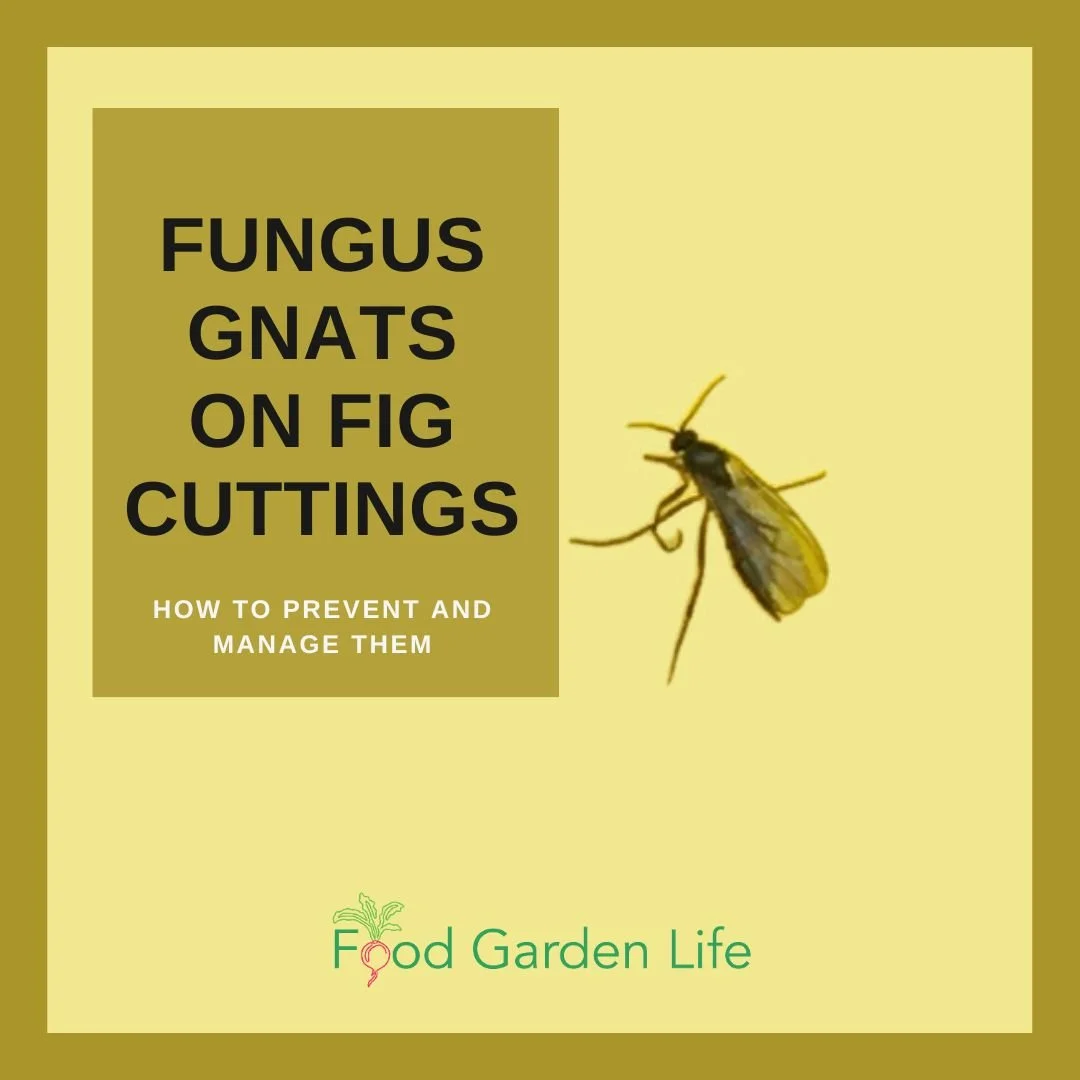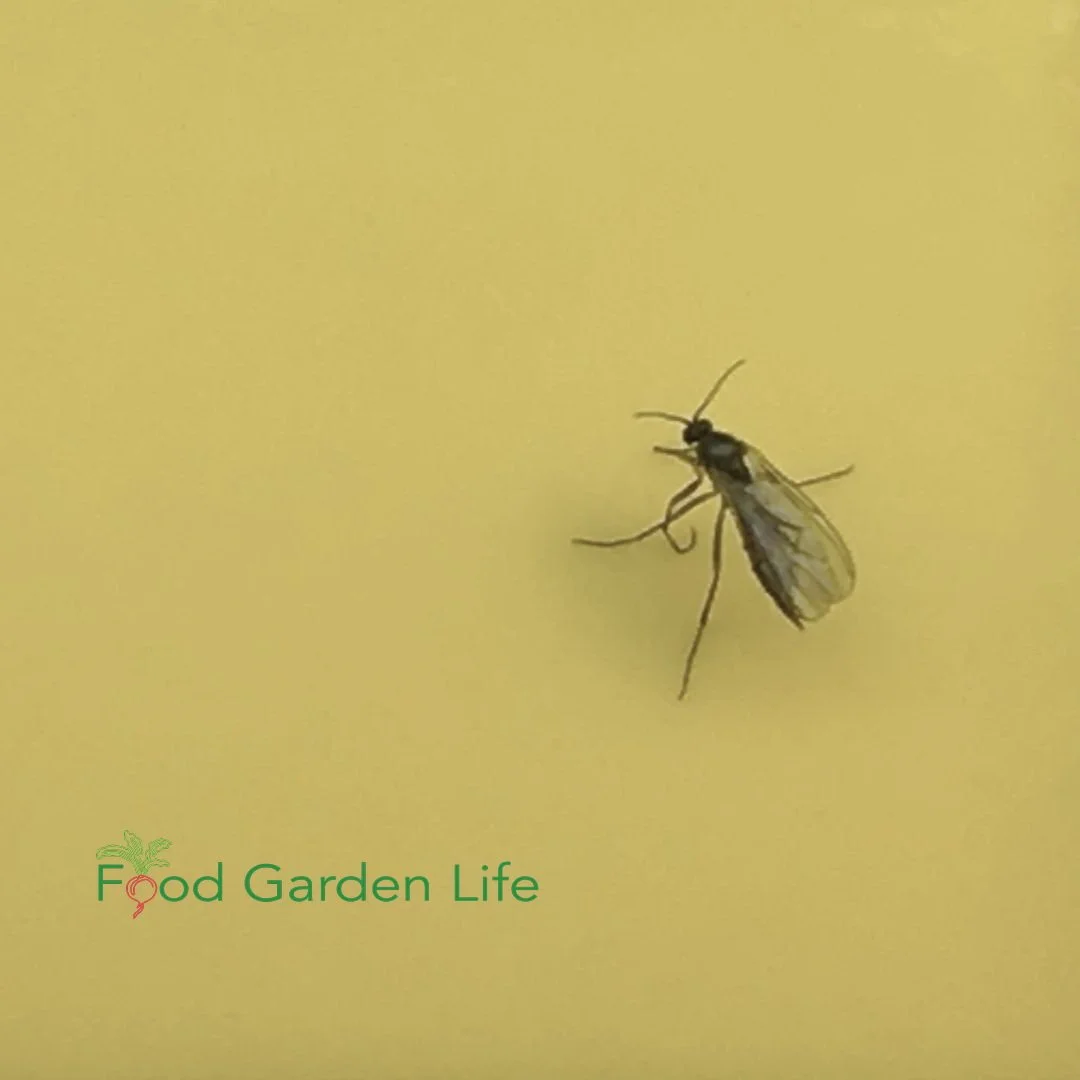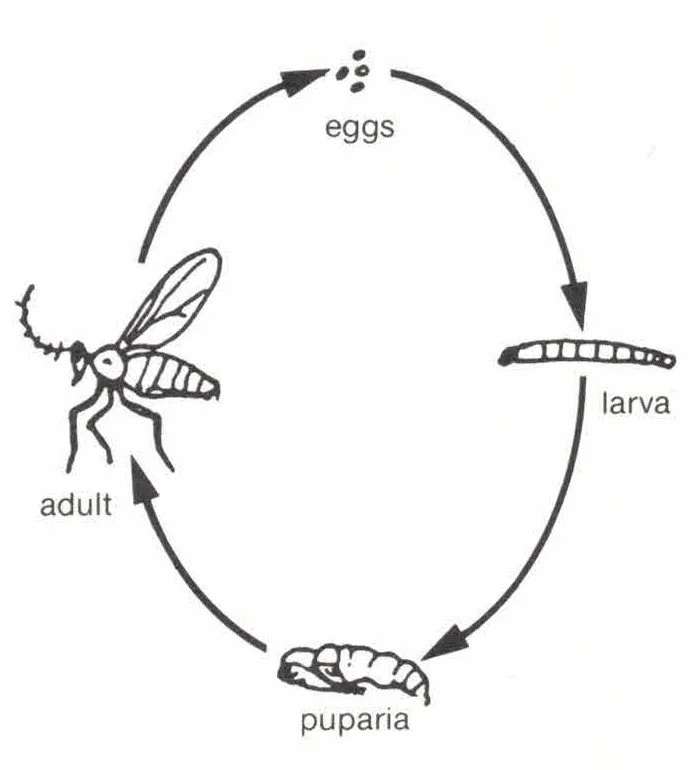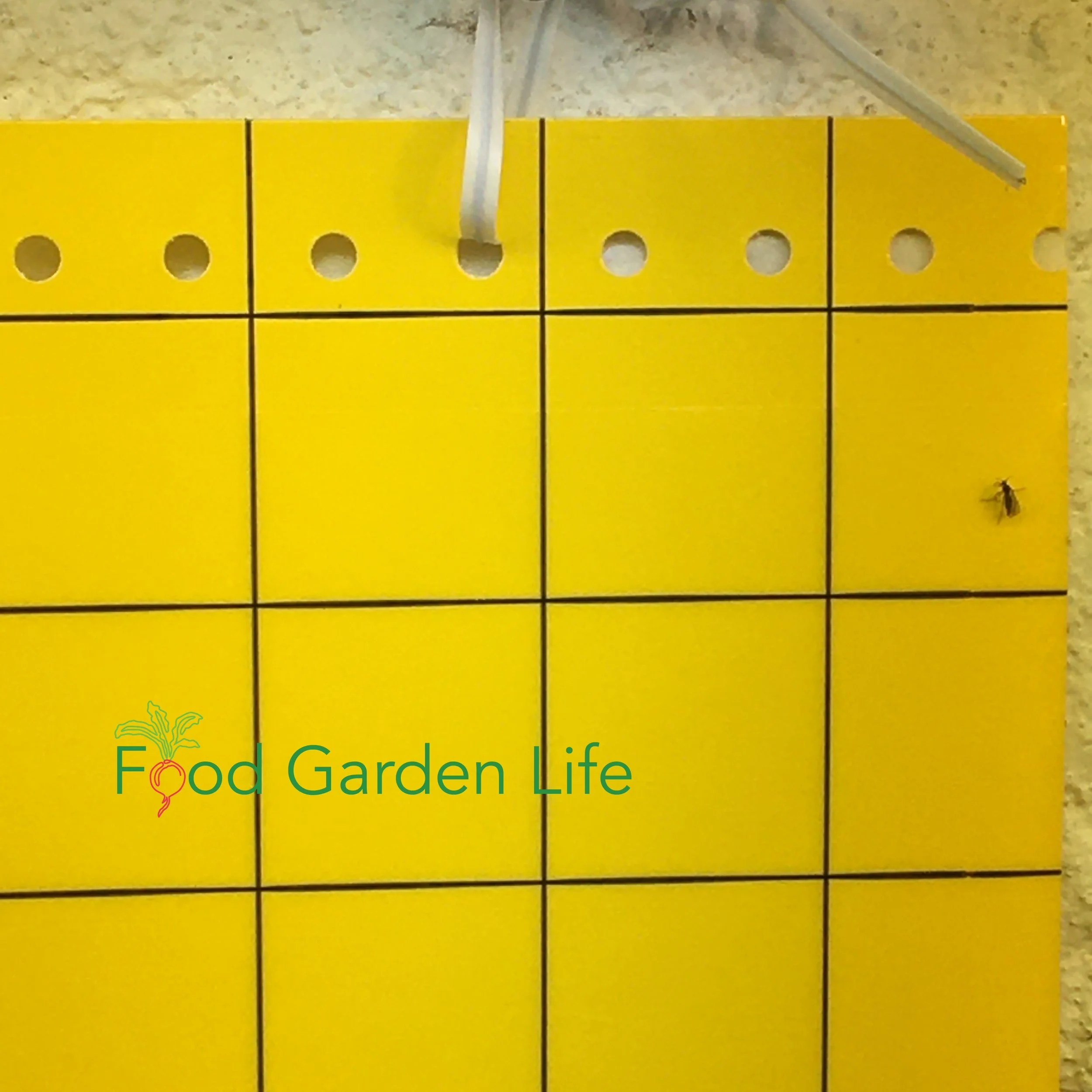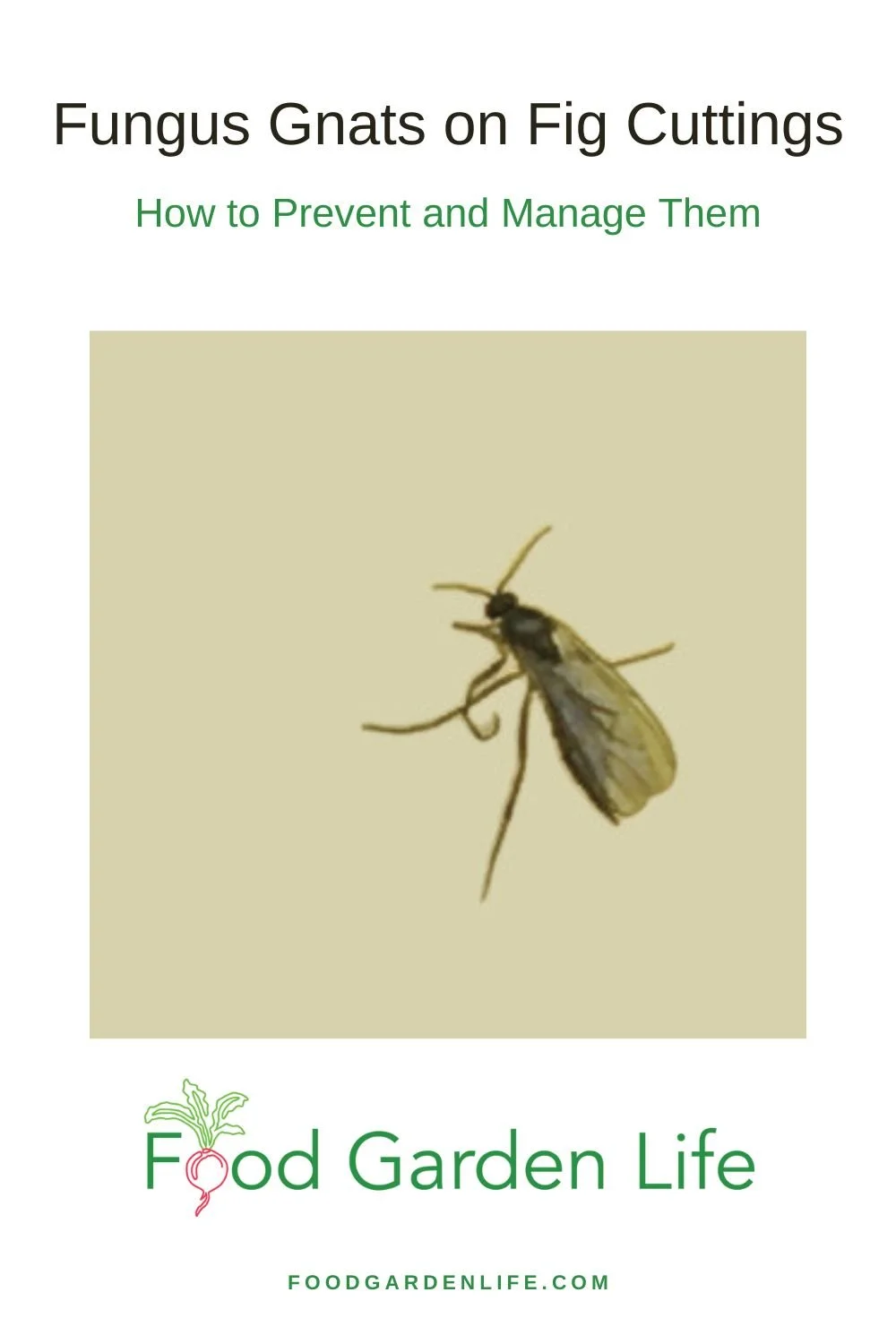Fungus Gnats and Fig Cuttings
Fungus gnats can cause a lot of damage to fig cuttings.
It was during a Zoom meeting.
Right in front of my face.
It was so close I nearly inhaled it.
A fungus gnat. They’re back…and that’s bad news for my fig cuttings.
What’s a Fungus Gnat?
It’s easy to mistake an adult fungus gnat for a fruit fly.
The adults are small flies, about 4 mm (1/8th of an inch) long. Their little bodies are jacked up on long skinny legs, making them look top heavy.
Fungus gnats are weak fliers…anything but graceful. Their flight is bumbling at best, like the pigeons of the flying insect world.
If you have fungus gnats, you’re likely to see them flying around your houseplants. Others will be walking around the soil surface.
Fig Cuttings and Fungus Gnats
An adult fungus gnat.
Here’s where fig cuttings come into this: If you see adult fungus gnats, then there are lots of larvae somewhere.
The larvae are small worms that live in the soil. They’re difficult to see with the naked eye. But if you’ve got adults, there are larvae around.
These larvae—these worms—eat decaying organic matter…AND roots.
Mature plants are not usually bothered by fungus gnats; they can take some root damage.
But fungus gnat larvae can mow down your fig cuttings. (OK, mow up…they’re munching on the newly forming roots.)
Fungus Gnat Life Cycle
Fungus gnat life cycle
Adult fungus gnats live for about a week. The female gnat lays a lot of eggs in that short time.
Eggs hatch into larvae
Larvae pupate
The cycle repeats
The full life cycle is about 21 days at 24°C (75°F). It takes longer at cooler temperatures.
Understanding this life cycle helps you managing fungus gnats.
You want to break the cycle. To do this, go after the fungus gnats at more than one stage.
Find Out How to Grow Your Own Figs
Harvest more figs this year! Grow Figs in Cold Climates Masterclass shows you how to grow a fig tree in a pot, or outside with protection. So you can harvest lots of figs!
Where Fungus Gnats Come From
Fungus gnats can arrive with the soil in new houseplants. They can also arrive with contaminated potting soil. Potting soils aren’t usually sterilized, so it’s possible to have fungus gnat eggs in potting soil.
Control Fungus Gnats on Fig Cuttings
The most common advice for controlling fungus gnats is to water less. That’s because the larvae need moist soil.
This advice works well with houseplants.
But when we’re rooting fig cuttings in potting soil, we want moist conditions so that the cutting does not dry out.
That means we need to use some other tactics to manage fungus gnats with fig cuttings.
Below are a few ways to control fungus gnats on fig cuttings. Use more than one tactic for the best results.
Start Fig Cuttings in Fungus-Gnat-Free Potting Soil
Fungus gnat eggs can come with a batch of potting soil. No big deal for most house plants…but with fig cuttings you don’t want fungus gnats.
So if there’s a chance your you have fungus gnat eggs in your potting soil, sterilize it.
(Commercial potting soil mixes aren’t usually sterilized. That’s fine because, there are often beneficial microbes in them. If you’re confident the soil you’re using is free from fungus gnats, no need to do this.)
On a home scale, you can use heat to sterilize potting soil. A temperature of 180°F (80°C) for half an hour does the trick (as well as destroying weed seeds and disease organisms.)
So you’re probably asking what it smells like if you put soil in your oven! It smells like…soil. And if that’s an issue, just do this on your BBQ.
Pre-Root Your Cuttings
Fig cuttings pre-rooted in a bag. This is a good way to give fig cuttings a head start so that’s there’s a shorter period of time when they’re very susceptible to fungus gnat damage.
It’s as they just begin to root that your fig cuttings are especially susceptible to fungus gnat damage. So one strategy is to pre-root your fig cuttings before you pot them up.
Wrap all but the bottom inch of your fig cuttings in damp paper towel, and then enclose them in a sealed clear plastic bag. (Clear, so that you can watch the progress.)
Then leave the bag at room temperature for root formation to begin.
First you’ll get white splotches forming on the bottom of the cuttings. These eventually turn into roots. And once you have roots formed, you can pot up your rooted cuttings.
(Some people use a similar technique, putting cuttings in a sealed bag with perlite.)
With roots already formed, your cuttings have a good head-start and are likely to outgrow any fungus gnat problems.
Grow Your Fig Cuttings Away from Potted Plants
Knowing that potted plants are often a source of fungus gnats, start your fig cuttings away from potted plants.
A fungus gnat caught on a yellow sticky trap.
Yellow Sticky Cards for Adult Fungus Gnats
Yellow sticky cards are helpful for monitoring for fungus gnats. They are placed around plants to catch adult fungus gnats.
But sticky traps alone don’t control fungus gnats.
Use sticky traps in conjunction with other fungus-gnat-control strategies.
Nematodes
Nematodes are microscopic worm-like creatures that kill the larval stage of fungus gnats. Buy them from suppliers of biological controls.
Nematodes are applied with water. When you receive them, you’ll mix them with water, and then water them onto the soil.
When using nematodes, keep the potting soil moist as they need a moist environment.
Steinernema feltiae nematodes, used to control fungus gnats.
There are many species of nematode, and some are used for biological control of garden pests such as white grubs.
The nematode for fungus gnat larvae is Steinernema feltiae.
Nematodes have no effect on adult fungus gnats.
More than one application is best. That way you get the larvae in the soil at the time of application, but also larvae that emerge later from eggs.
BT
BT (short for Bacillus thuringensis) is a naturally occurring bacterium.
If you recognize the name, it’s probably because it’s often used for mosquito management—and there is also a type that’s used for controlling caterpillars in the garden.
The BT for fungus gnats is Bti (Bacillus thuringensis israelensis).
Don’t buy Btk (Bacillus thuringensis kurstaki); it’s used for caterpillars.
Depending on the formulation, the BT can mixed with water and watered onto the soil, or incorporated into the potting soil.
The fungus gnat larvae ingest the BT and die.
Repeat weekly, 3 or 4 times so that you get the larvae in the soil at the time of application, but also larvae that emerge later from eggs.
Find out more about BTi formulations.
Root Fig Cuttings in a Bag
Plant your fig cuttings in fungus-gnat free soil that’s isolated from fungus gnats in a plastic bag. The damp soil is in the bag, the bottom of the cutting is inserted into the soil, and the top of the cutting sticks out above.
Seal tightly so no fungus gnats can get to the soil.
If you use clear bags, you can see the progress of rooting.
Some people call this the “fig pop” method.
Fungus Gnats and Fig Cuttings: Putting it all Together
Fungus gnats come with potting soil and house plants. Having them isn’t a sign that you’ve done anything wrong.
And normally they’re not a big deal.
Except they’re a very big problem if you have fig cuttings—because they damage the newly emerging roots.
When you’re managing fungus gnats:
Use more than one control strategy
Repeat treatments so that newly laid eggs or newly hatched larvae are controlled
Remember that one adult gnat flying around can lay lots of eggs…so be diligent.
More Fig-Growing Tips and Ideas
Fig Course
Find Out How to Grow Your Own Figs
Harvest more figs this year! Grow Figs in Cold Climates Masterclass shows you how to grow a fig tree in a pot, or outside with protection. So you can harvest lots of figs!

